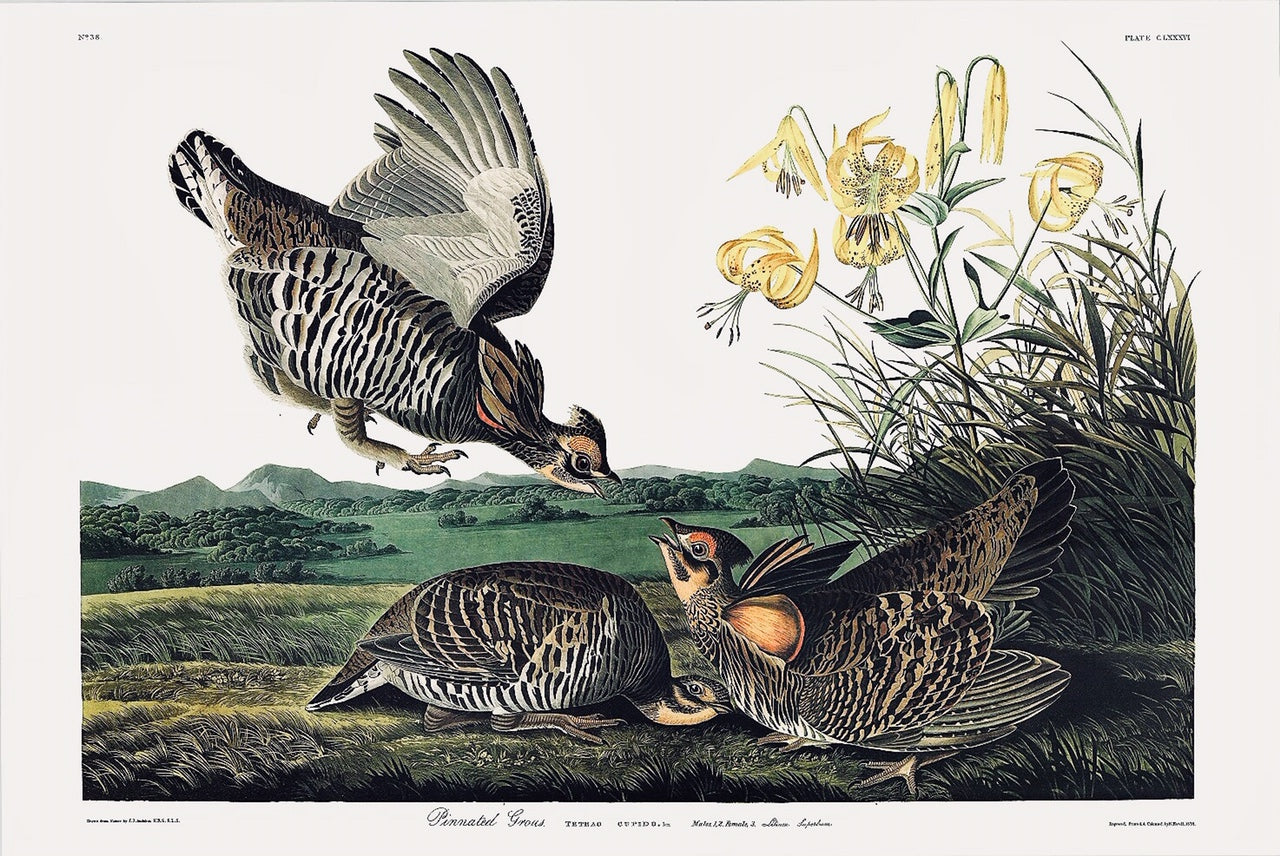Pinnated Grous
The Pinnated Grous
Princeton Audubon Double Elephant Edition •Double elephant (life size - 26 1/4 x 39 1/4) •Limited edition of 1500. •Pencil-numbered and embossed with the Princeton Audubon Limited seal. •Up to 11 color plates used. •Specially developed fade-proof inks. Absolute color fidelity to the actual original. •Printed on a 300 line. •Very heavy archival paper which is recommended by the Library of Congress for archives and is specially toned to match the actual color of the antique originals. •Registered to purchaser. •As permanently displayed at The Royal Society of London, to which Audubon belonged as a Fellow.
About the image itself ...
This painting was probably done in 1824, when Audubon was near the Great Lakes. It depicts two males fighting over a female and is one of the few works in which Audubon drew all three of the compositional elements: birds, plants, and landscape. Of the tiger lily Audubon wrote: "This beautiful plant,...grows in swamps and moist copses, in the Northern and Eastern States, as far as Virginia, as well as in the western prairies,...I was forced to reduce the stem, in order to introduce it into my drawing, the back ground of which is an attempt to represent our original western meadows."
The greater prairie chicken, found in such abundance by the artist when he lived in Kentucky, is now uncommon and seriously declining over much of its range. During the mating season the males in a given area gather in the early morning on courtship grounds, there to display before the females. As described by Dr. Frank M. Chapman: "The feather-tufts on either part of the neck are erected like horns, the tail raised and spread, the wings drooped, when the bird first rushes forward a few steps, pauses, inflates its orange-like air-sacs, and with a violent, jerking, muscular effort, produces the startling boom, which we may have heard when two miles distant." The booming note is much like one made by blowing across an empty bottle.
The Pinnated Grous
Princeton Audubon Double Elephant Edition •Double elephant (life size - 26 1/4 x 39 1/4) •Limited edition of 1500. •Pencil-numbered and embossed with the Princeton Audubon Limited seal. •Up to 11 color plates used. •Specially developed fade-proof inks. Absolute color fidelity to the actual original. •Printed on a 300 line. •Very heavy archival paper which is recommended by the Library of Congress for archives and is specially toned to match the actual color of the antique originals. •Registered to purchaser. •As permanently displayed at The Royal Society of London, to which Audubon belonged as a Fellow.
About the image itself ...
This painting was probably done in 1824, when Audubon was near the Great Lakes. It depicts two males fighting over a female and is one of the few works in which Audubon drew all three of the compositional elements: birds, plants, and landscape. Of the tiger lily Audubon wrote: "This beautiful plant,...grows in swamps and moist copses, in the Northern and Eastern States, as far as Virginia, as well as in the western prairies,...I was forced to reduce the stem, in order to introduce it into my drawing, the back ground of which is an attempt to represent our original western meadows."
The greater prairie chicken, found in such abundance by the artist when he lived in Kentucky, is now uncommon and seriously declining over much of its range. During the mating season the males in a given area gather in the early morning on courtship grounds, there to display before the females. As described by Dr. Frank M. Chapman: "The feather-tufts on either part of the neck are erected like horns, the tail raised and spread, the wings drooped, when the bird first rushes forward a few steps, pauses, inflates its orange-like air-sacs, and with a violent, jerking, muscular effort, produces the startling boom, which we may have heard when two miles distant." The booming note is much like one made by blowing across an empty bottle.
